Writing a construction proposal can be one of the toughest parts of being in business. Those who write them for a living find it an intimidating process. You are persuading a potential client, or “issuer,” to choose your company over the competition, which means you have a lot weighing on your mind. Keep in mind when reading this that no two construction proposals are alike, just like no two projects are alike.
This article is to serve as a guide only, as each proposal must be tailored specifically for each job. However, there are certain elements that should be included in all, and we’ve outlined them below.
Construction Proposal Templates
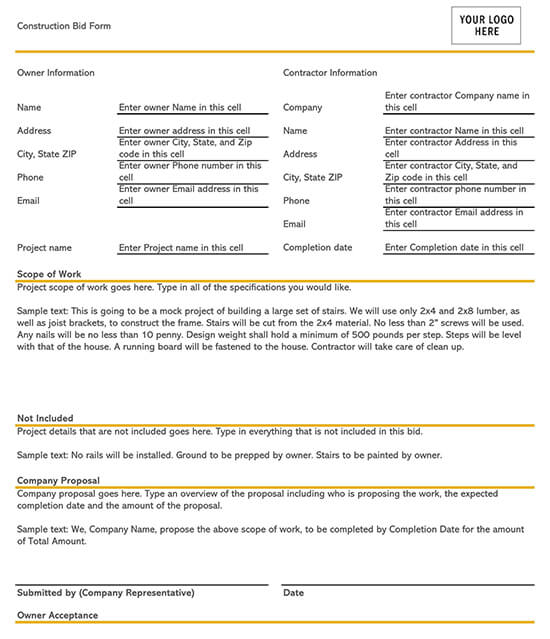
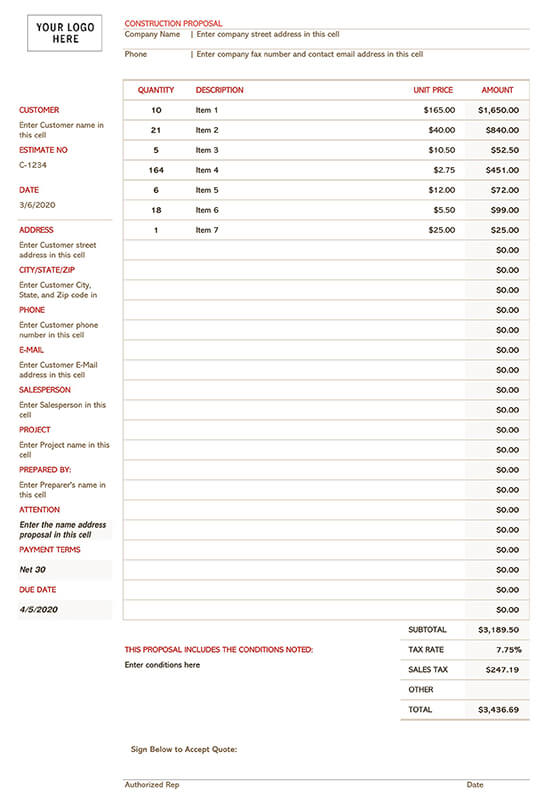

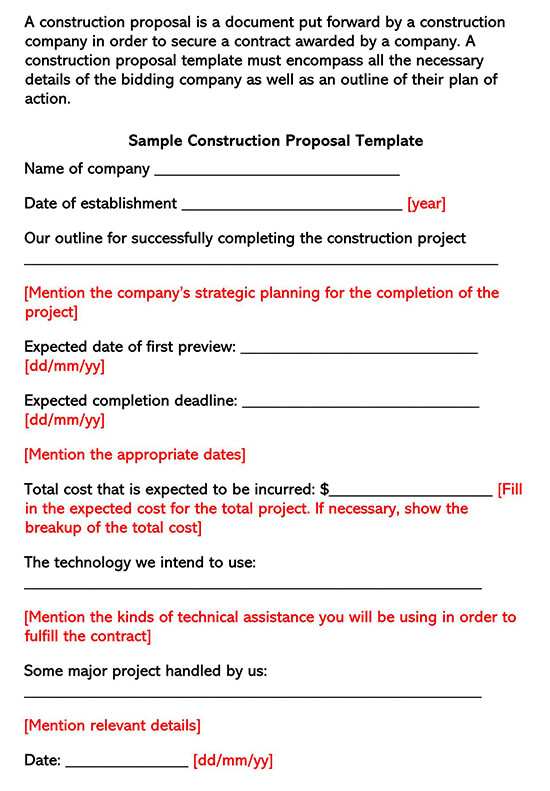
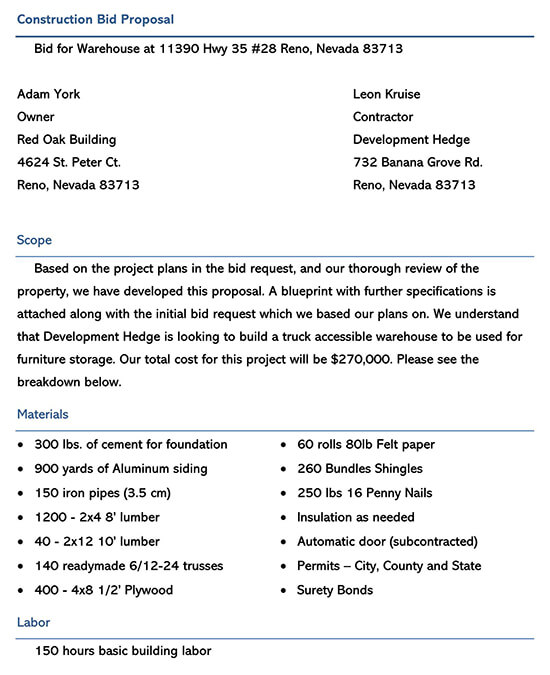
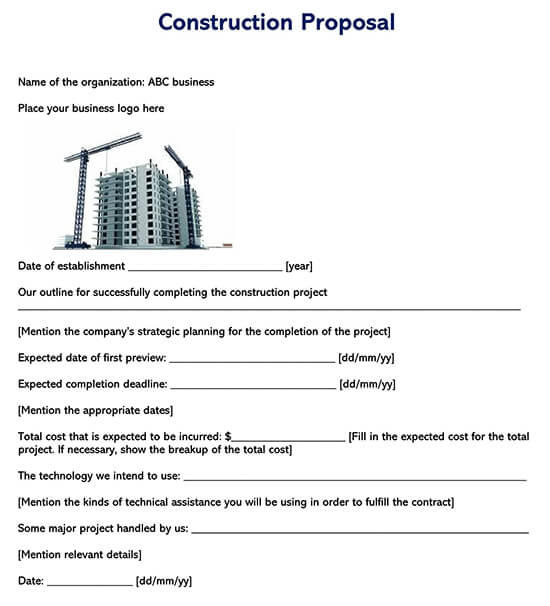
Important Considerations All Construction Proposals Should Adhere To
When you’re drawing up your first construction proposal, it can be pretty nerve-wracking. However, don’t worry, because people who professionally write them for a living feel the exact same way. After all, there’s a lot riding on the back of it: money, reputation, and dependability. That’s why it’s crucial for beginners to study just how one is written. Before you sit down to write it, below are a few elements to consider before you put pen to paper.
Get a grip on the project
Even if you’ve successfully completed other similar construction projects, you must still concern yourself with the details of each new project. You do this by studying blueprints and visiting the job site in person. Take this time to ask any questions or mention any missing elements you notice. Now is the time to see if you’ll require additional subcontractors or not in order to fulfill some of the requirements of the RFP. Go over the materials required and do cost estimates.
It is a legal document
A properly crafted construction proposal is considered a legal document. As such, all parties involved need to be identified in the document. This means that it must include the names, addresses, contact information, and signatures of those involved. Only when this information is included will it be considered valid in a court of law.
Scope of work
If this is your first time preparing a construction proposal, then know that it is essential that you include the scope of work in it. The scope of work refers to the duties of the issuer’s requests. As this is a legal document, make certain that you can perform these duties before you agree to the terms. Generally, in the scope of work, all duties are broken down into tasks, each with its own milestone date and special requirements.
Work schedule or timeline
Also, remember to include a work schedule. A work schedule is nothing more than a tool to assist you in managing the project. Here, you’ll state when the project will begin and when the project will terminate, as well as when certain individual tasks must begin and end. By doing so, you’ll show the client that you have a logical and realistic roadmap for project completion, from beginning to end.
Know the costs involved
Every construction proposal needs to let the issuer know the costs of the project, as well as any costs you’ve come across that are beyond the scope of work but are necessary for project completion. Be as specific as you can. If you underprice just to nab the contract, you may end up having to pay for goods/services out of your own pocket, which defeats the purpose of winning a contract.
Add visuals
Visuals are not necessary, but they can make it easier to digest, all the same. By using images, you’ll be able to give the reader some visual relief as well as break up the content. Images such as infographics, graphs, and tables can be used to put your facts into an easy-to-read form. If you’re concerned about how to obtain the photos, know that there are quite a few places online, such as pixabay.com, where you can get good quality royalty-free images.
Qualifications
It is absolutely crucial that you include your qualifications as you write. You may be the best company for the job, but if it can’t back it up with actual statistics, then the issuer will most likely select a company that does. Remember, they don’t know you; they don’t know what you and your company can do or what you’ve achieved. Always include any situation where you’ve solved a similar issue successfully, as well as customer testimonials, awards, and any other data that serves as social proof that you are capable of finding a solution.
Pay attention to the evaluation or selection criteria
Make sure you’ve actually read the RFP. Know the customer and what they want, and be honest with yourself when it comes to solving their problem. Another area to pay close attention to is their evaluation criteria. These are the factors that the issuer is going to used to measure each candidate. If you cannot meet just one of their criteria, then your proposal will be immediately tabled.
Protect yourself against unforeseen project changes
Always include a clause in the agreement that protects you against any sudden changes in the project. After all, you don’t want to be left holding the bag if the issuer makes an alteration that results in additional costs for you. Here, you’ll include a clause that states that in case of an unexpected change, you’ll need to be notified, and extra time will need to be allotted to you, as well as extra finances to cover the change.
Writing Your Construction Proposal
Below is a basic outline of your proposal. Know that each RFP or Request for Proposal, will be unique and require you to adapt yours to match what they want. For instance, in this construction RFP, the city is searching for a contractor with the ability to build an aquatic entertainment center in their city. The RFP informs potential contractors what the minimum qualifications are, as well as schedules and other requirements.
Create a title page
In order for it to be a legally binding document, it needs to mention all parties involved, and this is where the title page comes in. Your title page is where you place your company’s information, such as its name, address, contact information, and logo.
EXAMPLE
ACME Construction Proposal
Prepared for: [Client Name] [Company Name]
Prepared by: [Send Name] [Sender Company]
[Contractors Registration Number]
[Federal Identification Number, if Needed]
[Date Submitted]
Cover letter
The cover letter serves as a way for you to create a good first impression with potential clients. Nothing complex; just consider it a vehicle to introduce your company and how it is better than the competition. The tone should be friendly throughout. In closing, let your prospective client know you welcome any questions and thank them for their time.
Table of contents
This not only makes your proposal appear professional, but it’s also a common courtesy for the prospective client, especially if yours is a long one. The table of contents allows your prospective clients to easily flip from section to section as they study your document.
Executive summary
First things first. The executive summary is not a summary per se. The executive summary is where you sell your solution to the prospective client. Remember when you were in school and were taught how to write a persuasive essay? Well, those are some grammar school skills that you can put to work right now because that’s just what the executive summary is all about. You’re going to highlight just what your company can do for the issuer.
In fact, did you know that since many prospective clients must read so many construction proposals, they simply read the executive summary and your pricing section and move on to the next? To prevent this, you’ll need to grab their attention right off the bat. A good way to go about writing your executive summary if you’re a newbie is to write a rough draft of it first. Then, when you complete it, go back and edit it. This way, you have the rough draft as a basic outline, and when you complete it, you can go back and make any crucial additions or remove redundancies. In short, write the executive summary first, edit as needed, and when the proposal is complete, perform the final edit.
First of all, you need your opening sentence of the executive summary to be your “Hook”. A hook is used in essays to grab the readers’ attention. Next, you need to show the prospective client that you understand their RFP. You can do this by stating any previous experience you’ve had dealing with similar issues and then mentioning just how your solution will benefit them. Finally, it’s time for the clincher: why your company is better than the competition and how much you look forward to working with them on their project.
Keep the executive summary brief, around one page or so. Make sure it’s jargon-free. The client is looking for someone who can do what they can’t, so don’t assume they know tech talk. Concentrate on the client, their needs, and how you will benefit them.
Proposal section
This is where you’ll show the client just how you’ll solve their problem and do it better than the competition, and that’s the tricky part. In the real world, you may be the best company for the job. Yet the client chose another one, one who is not as good as you. This is where the proposal section comes in. In the aforementioned scenario, the reason the client chose an inferior company to yours is that theirs was more convincing than yours.
Convince and persuade
So, when you give your overview, know that it’s much more than stats, facts, and figures. It’s your ability to convince or persuade the issuer to choose you over anyone else. First of all, offering your clients a solid explanation as to why they should do something is key.
Consider the following questions as you write your proposal:
- What does the client need?
- Why should they select your company over the competition?
- What is the competition offering?
- Why is yours the best one for this project?
Take advantage of your testimonials
Take advantage of previous customer testimonials and use them to back up your claims. When you do this, you’re also validating the fact that you, indeed, are the best company for this project.
No techy talk
The issuer will probably have a stack of construction proposals to go through, so be kind and make yours easy to read. So, no high-tech jargon, no ten-dollar words, and no overly long sentences. Keep it light, concise, and easy to digest. Avoid an overly heavy, laborious, professional tone. Remember, you can’t persuade someone to use your company if you either bore them to death or write in such a way they don’t understand the word you’re saying.
Gain their trust
A well-crafted document will help you gain their trust. When you use the proper testimonials and company data to back up your claims as well as address their concerns, you’ve come a long way in gaining that trust. They will see you as a responsible individual to do business with, one they can trust to get the job done well and on time.
Services and methodology
This is where you’ll include a synopsis of your solution. Remember to keep this section free of technical jargon, make it easy to read, and assume that the prospective client has no idea as to the process involved. This means you’ll be taking them through the process, step by step, in easy-to-understand layman terms.
EXAMPLE
Create a milestone table.
Here, you’ll be listing all of your deliverables, along with the time each one will be completed. By doing so, you’ll instill confidence in the client. You’re showing that you are responsible. Anticipate their questions and answer them within this section, always keeping in mind their evaluation criteria, as your proposal must meet their evaluation criteria mentioned in the RFP.
If you are submitting a proposal for a large project and intend to use additional contractors for some of the parts, then make certain that you mention each party, what they’re in charge of, and their duties. This creates a pyramid of responsibility. Everyone knows their place, what you expect from them, and what they will deliver to you.
About us
Here is where you get your chance to really shine. Show your client what you’re made of by including your company’s successes. Here, you can use infographics to illustrate your company’s statistics and highlights. Also, be sure to include biographies of those who will be working on your project. Other items would be any awards you’ve won and client testimonials.
Pricing
When it comes to pricing, you have to take some time and really get the numbers right. Take your data and place it into neatly organized tables or a payment schedule. The prices need to be as accurate as possible without hurting your bottom line or scaring off your client. In other words, if your prices are too low, you may come out on the short end of the stick, having to fund some projects from your own pocket.
On the other hand, if your price is too high, you risk losing a client to a competitor who offers a price within their budget. Keep the table simple by having one column for the service, the next for the price, and the last table listing how many of what you’ll need. Include a subtotal, fees, taxation, and a total. If you are using a payment schedule, know that payment is expected after each task is completed.
Payment schedule
- $10,000 deposit upon execution of the agreement
- $2,000 after the plumbing is complete
- $3,000 after concrete pouring is complete
- $4,000 after electrical work is complete
- $2,000 after tile completion
Terms and conditions
In this section, you’ll be specifying the payment schedules and pricing. The best way to do this is to consult with your lawyer or the legal team.
EXAMPLE
If one of the terms is for the client to pay you upwards of 70 percent upon signing, you’d place that here. If you had a cancellation policy, then you’d also place it in this section.
Signatures
Have a section where all those involved in the project sign their full names to the agreement.
Construction proposal template 07
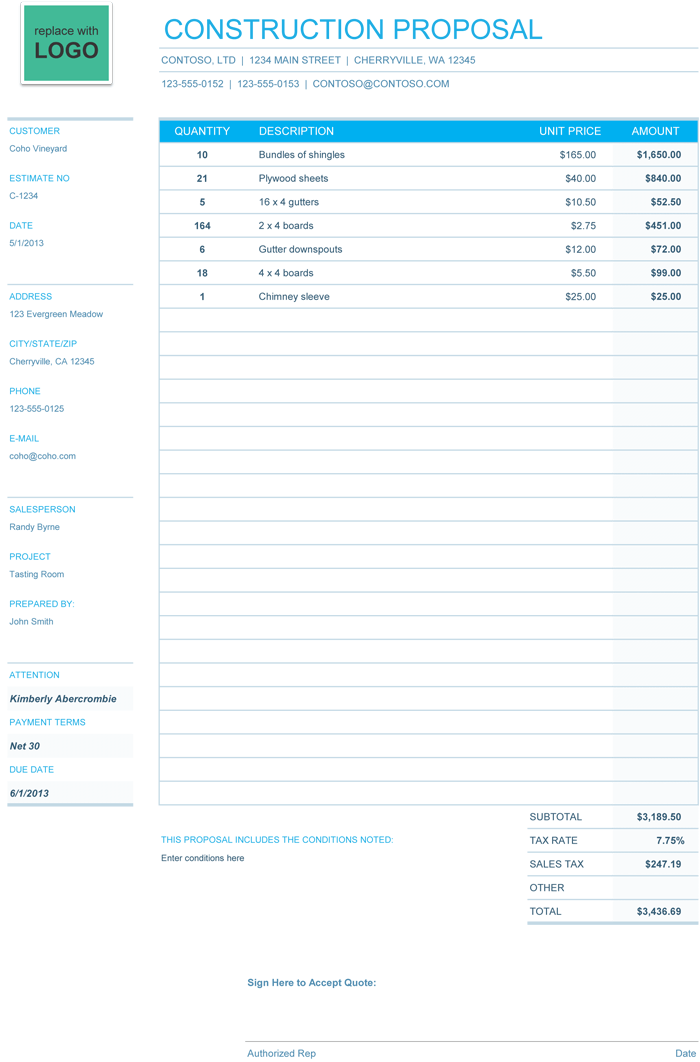
Construction proposal template 08
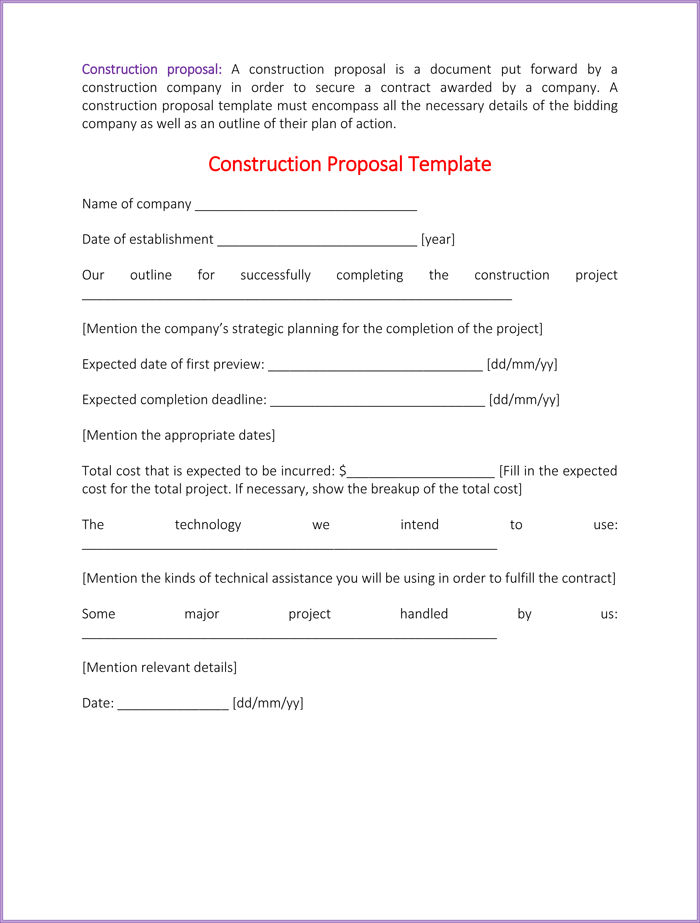
Construction proposal sample 09
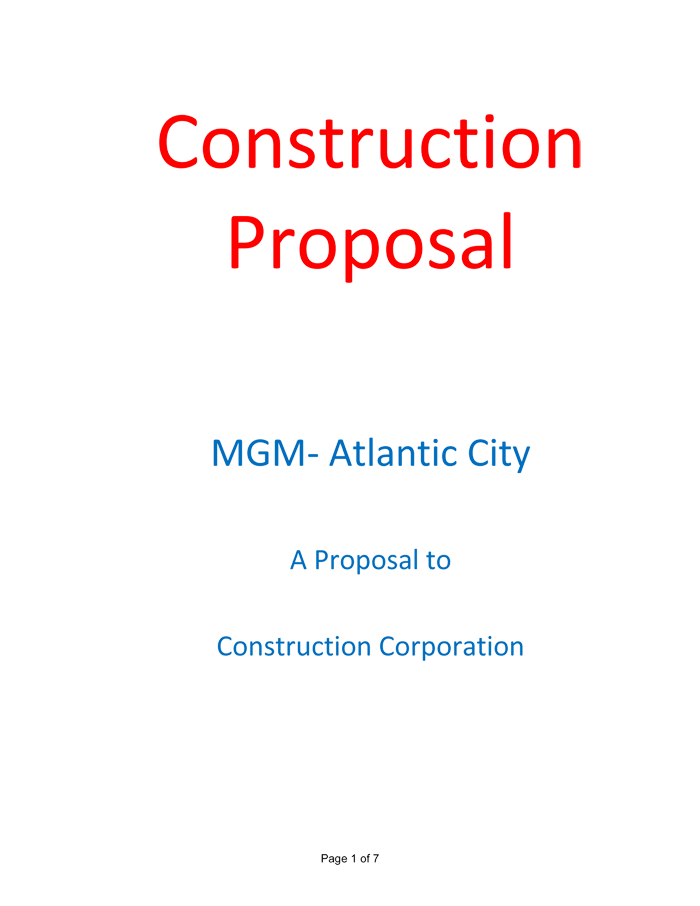
Construction bid form 10
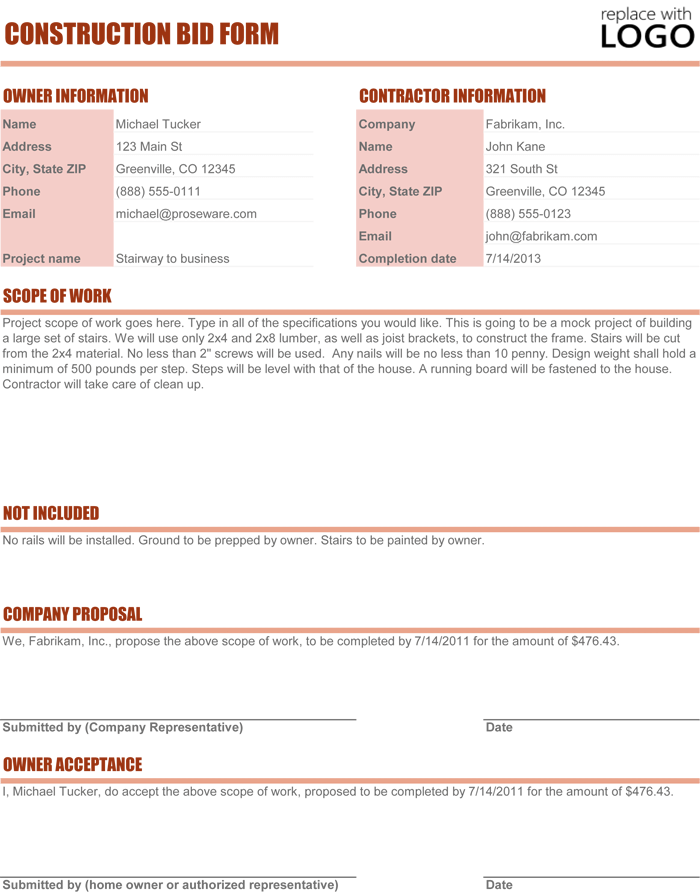
Construction Proposal Tips
- It’s often easier if you begin with an outline of the proposal. Take the sections we’ve listed above and create an outline for yourself. Edit and proofread as you go, to ensure that you’ve included only information relevant to the proposal.
- The executive summary alone should be all the client needs to read to understand what your business does and how you’ll solve their problem.
- Always mention your qualifications. You may have a stellar construction proposal, but in the end, it’s nothing but so many words unless you can back it up. Data, customer testimonials, awards, are all such things which can help you.
- If you’ve solved similar problems for other clients, it’s crucial that you mention them.
- The overall makeup of the construction proposal should fit your brand. This means company colors, design esthetics, and logo. Make this proposal shine! Engage the client. Images often help them turn the page.
- As previously stated, keep the proposal free from tech talk and easy to read. Always remember that the issuer will have many construction proposals to read once they send out the RFP. If you compose one that is too lengthy and full of unnecessary words and sentences, chances are they’ll just move on to the next one.
- Always back up your claims with valid data. It’s not good enough to say that you’re the best company for the task. Instead, you have to show them why you are the best company for the task.
- Always edit and proofread your proposal before sending it to the issuer. Nothing says incompetence more than misspelled words, or run-on sentences.
Final Thoughts
A construction proposal is a method of persuading an issuer of an RFP, that you are the perfect company to solve their problem. Always include who you are, what your company does, and the issue the potential client needs to be addressed. You then present a solution to the issuer, how your company will implement this solution, along with deliverables, milestones, costs, and terms and conditions. By using our construction proposal templates, all of the aforementioned will fall neatly in place, and you’ll be well on your way to writing a winning proposal for you and your company.




